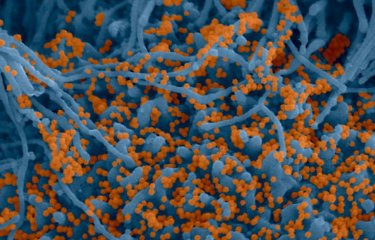-
Document de presse | 2013.05.05
Chikungunya : discovery of a human-specific factor involved in the virus replication
Scientists from the Institut Pasteur, Inserm and CNRS, have identified a human-specific factor involved in the replication of Chikungunya virus which accounts for the species specificity of this virus. Chikungunya virus is an emerging virus that in 2005 caused, for the first time, an outbreak in La Réunion island, a French overseas district where more than 30% of the population was infected, and...
-
Document de presse | 2012.10.31
New Finding Helps Explain Antibiotic Resistance in Staphylococcus aureus
Researchers at the Institut Pasteur, the CNRS, and the University of Tsukuba Faculty of Medicine (Japan) have proven for the first time that activating a specific gene in Staphylococcus aureus enables it to incorporate extracellular DNA and develop resistance to methicillin. They have also identified two mechanisms for the activation of the gene in question. These results represent an important...
-
Document de presse | 2012.10.08
Rooting out the Cause of Blindness in Type 1 Usher Syndrome
Researchers from the Institut Pasteur, the Institut de la Vision, Inserm, and the Pierre and Marie Curie University have determined the cause of blindness associated with type 1 Usher syndrome (the most common genetic cause of deafness and blindness in humans). They have also shown why rodents, the only animal model currently available for research on this disease, are invulnerable to the vision...
-
Document de presse | 2012.09.26
Malaria Takes a Hit – Two New Molecules Stop P. falciparum in its Tracks
Researchers at the Institut Pasteur and the French National Center for Scientific Research (CNRS), in collaboration with Imperial College London, have synthesized two molecules capable of quickly and irreversibly stopping the growth of P. falciparum at every blood stage of its life cycle. These molecules work by inhibiting the histone methyltransferase enzymes necessary for the parasite’s...
-
Document de presse | 2012.09.13
Institut Pasteur and WHO join forces in the fight against epidemics
On Thursday September 13, in Geneva, the Institut Pasteur and the World Health Organisation (WHO) signed a cooperation agreement concerning the response to epidemics and worldwide health safety. Their aim is to help countries to strengthen their capacities for surveillance, detection and response in application of the International Health Regulations drawn up by WHO. Press release Paris,...
-
Document de presse | 2012.06.13
A major discovery in the fight against streptococcal infections
Group B streptococcus, or Streptococcus agalactiae, is responsible for infections of the bovine mammary gland (mastitis), and can also cause serious diseases in humans (e.g. pneumonia, meningitis, septicemia), particularly in neonates. Researchers at INRA and the Institut Pasteur demonstrated the key role played by a molecule known as antigen B, located on the surface of the bacterium. Their...
-
Document de presse | 2012.06.11
Dormancy of stem cells enables them to remain viable…many days post mortem
Under the direction of Fabrice Chrétien*, in collaboration with Shahragim Tajbakhsh**, researchers from the Institut Pasteur, the Université de Versailles Saint-Quentin-en-Yvelines, the Paris Public Hospital Network (AP-HP), and the CNRS have shown for the first time in humans and mice, the capacity of stem cells to adopt a dormant state when their environment becomes hostile, including several...
-
Document de presse | 2012.05.15
A new optical microscopy approach opens the door to better observations in molecular biology
Researchers from the Institut Pasteur and CNRS have set up a new optical microscopy approach that combines two recent imaging techniques in order to visualize molecular assemblies without affecting their biological functions, at a resolution 10 times better than that of traditional microscopes. Using this approach, they were able to observe the AIDS virus and its capsids (containing the HIV...
-
Document de presse | 2012.05.13
Learning and memory: the role of neo-neurons revealed
Researchers at the Institut Pasteur and the CNRS have recently identified in mice the role played by neo-neurons formed in the adult brain. By using selective stimulation the researchers were able to show that these neo-neurons increase the ability to learn and memorize difficult cognitive tasks. This newly discovered characteristic of neo-neurons to assimilate complex information could open up...
-
Document de presse | 2012.04.18
A new hope in the fight against tuberculosis
Researchers from the Institut Pasteur and Inserm, in collaboration with researchers from the University of Pisa, have uncovered the key role played by specific proteins in the virulence of the mycobacterium responsible for tuberculosis, Mycobacterium tuberculosis. They were able to create an attenuated strain of the mycobacterium, which confers a better protection against tuberculosis than the...


